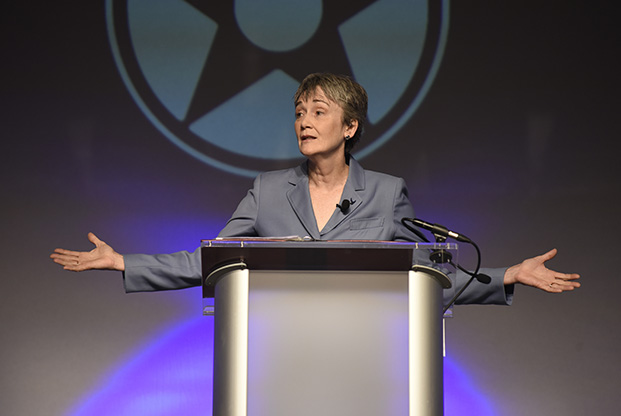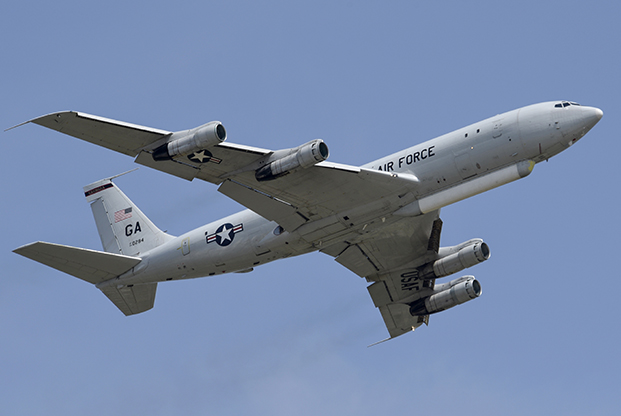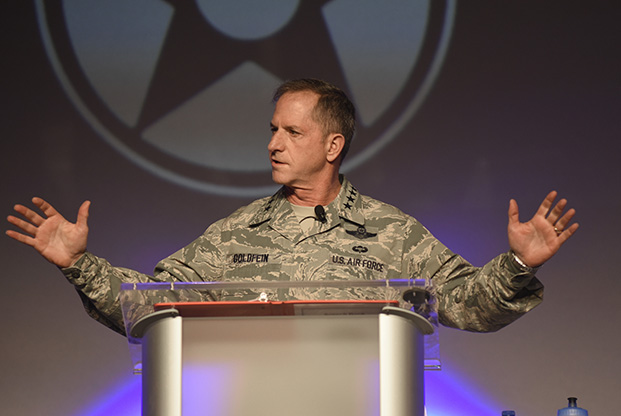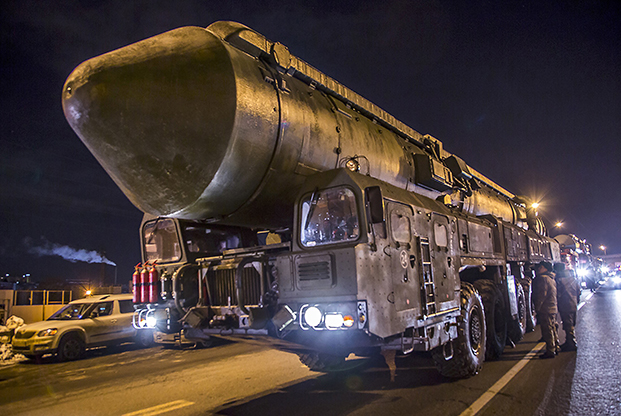
Air Force Secretary Heather Wilson addresses the crowd at AWS18. Wilson says airmen must think for themselves about how to execute missions. Staff photo by Mike Tsukamoto
The US is facing a new age of “great power conflict.” Potential adversaries Russia and China are reaching or surpassing American military capabilities and are using this newfound strength to intimidate neighbors and circumvent the established world order. To stay in front and counter these threats, the Air Force needs to innovate and must rethink how it operates on the global stage.
This was the message from Chief of Staff Gen. David L. Goldfein and Air Force Secretary Heather Wilson at the Air Force Association’s Air Warfare Symposium in late February in Orlando. The event, which focused on the central theme of innovation, came shortly after the Pentagon released its National Defense Strategy, which warns of this possible conflict with Russia and China.
Wilson, kicking off the event, said the new strategy shows what “all of us for several years have been realizing,”—that there is a “more competitive and dangerous environment than we have seen in generations.”
The US currently does not “control the pace of innovation,” she said. While the US military still has a “powerful advantage,” rival nations have repeatedly stolen the technology Americans have developed and used this to rapidly catch up.
“The National Defense Strategy directs us to be more lethal and a more ready force to strengthen alliances and partnerships, and to deliver a greater and more affordable performance in order to compete, to deter, and when called upon, to fight and win,” Goldfein said in his keynote address.
_Read this story in our digital issue:
The Air Force for almost three decades has operated in permissive environments, targeting terrorists in areas where it had full control of the airspace. But in this new environment, air superiority cannot be assumed. The US has no “preordained right to victory on the battlefield,” Goldfein warned. Facing this reality requires new ways to address certain missions and creative changes in the way the service operates.
“We’re going to have to expect you as airmen to take mission orders and execute in an environment where command, control, and communication is not assured, and still prevail,” Wilson said. “That requires airmen who think, innovate, and get after the mission without being told how to do everything.”
Wilson highlighted one specific airframe and mission that needs to be reshaped. The Air Force’s airborne battle management airframe, the E-8C JSTARS, needs to be replaced. Until recently, the Air Force planned to buy another airframe to take over this mission. But as the need to operate in a denied environment has become more and more important, the Air Force’s thinking changed.
Instead of buying a new airframe, the service is rethinking how battle management can be accomplished. This may include additional ground-based operators, working with space-based assets and aircraft such as MQ-9 Reapers or RQ-4 Global Hawks, all equipped with more integrated sensors.
The service in its Fiscal 2019 budget request outlines this plan, but USAF will have to convince a skeptical Congress. The Air Force must prove its point because if it is forced to buy another big airplane, Wilson said that aircraft would not last long in contested airspace.
“If that’s the solution, it won’t survive, she said.

An E-8C JSTARS aircraft evacuates to Tinker AFB, Okla., to escape the path of Hurricane Irma in September 2017. The JSTARS mission endures, but the Air Force no longer views a large aircraft as the best solution. Photo: Greg L. Davis/USAF
SHIFTING PARADIGMS
Private-sector companies have become increasingly nimble in recent years, while the military often has been constrained by cumbersome acquisition processes. The Air Force needs to strip away as many bureaucratic hurdles as possible and find new ways to quickly get advancements into the field. To that end, the service is using its Spark Tank innovation contest and its AFWERX startup to connect to a broader scientific enterprise. These new approaches are “absolutely vital to our future,” Wilson said.
“From the lab bench to the flight line, it’s not just about who has the best ideas,” Goldfein said. “What matters for us is who can act on these ideas and deliver the lethality that outpaces our adversaries? And I would offer to you in today’s complex global security environment, victory goes not [to the] innovator, but to the rapid integrator of ideas.”
The Air Force must “push up the throttles” in finding “game-changers” in the lab and in new partnerships with academia and industry. Meanwhile, USAF must find a way to “untether” the professional acquisition workforce inside the service by pushing the decision authority down to program managers, Goldfein said.

USAF Chief of Staff Gen. David Goldfein speaks on innovation at the Air Force Association’s Air Warfare Symposium in Orlando, Fla., in February. Staff photo by Mike Tsukamoto
Now is also a time of rapid space innovation. Companies such as SpaceX are launching new rockets more often and cheaper, and Amazon and Google are promising to soon create Internet-like options from space through the use of thousands of miniature satellites. These innovations need to be embraced and adopted by the Air Force as a way to get ahead of adversaries.
“For an airman, these are exciting technologies. Rocks in our sling,” Goldfein said. “If only we can think and act like David, like competitors in the ring. If we’re able to embrace the increasing speed of technological advancement and adapt faster than our adversaries.”
Space needs to be central in how the Air Force thinks, because its importance is only going to grow, Goldfein said.
“It is time for us, as a service, regardless of specialty badge, to embrace space superiority with the same passion and sense of ownership as we apply today to air superiority,” Goldfein said. Space needs to be more fully integrated with air and cyber operations in joint campaigns.
Going forward, the Air Force will push space integration from the very beginning of an airman’s development, Goldfein said. He directed Lt. Gen. Steven L. Kwast, commander of Air Education and Training Command, to “revolutionize” how the service trains its officers and NCOs to conduct space operations.
This is needed, Goldfein said, because a war in space is coming.

A Russian RS-24 Yars mobile nuclear missile system is prepared for a military parade in Red Square, Moscow, on Feb 27. USAF says potential adversaries Russia and China are bolstering military strength to intimidate their neighbors. Photo: Russian Federation Ministry of Defense
“I believe we’re going to be fighting from space in a matter of years, and we’re the service that must lead joint war fighting in this new contested domain,” Goldfein said. “It’s what the nation demands.”
This isn’t the first time the service has been in a similar situation.
In 1945, Gen. Henry H. “Hap” Arnold, the morning after the victory over Japan in World War II, proclaimed that the next war “may be fought by airplanes with no men in them at all. … Take everything you’ve learned about aviation and throw it out the window. It will be different than anything the world has ever seen,” Goldfein quoted Arnold, saying this was a visionary look at what the US military would face decades later.
Goldfein similarly sees a “vastly different future for our Air Force in 2045.” Unlike the period from 1945-1990, this will be in a world where the private sector often takes the lead in rapidly accelerating, militarily useful technology. And unlike the period from 1990-2014, USAF in 2045 is expected to face great power competition.
“So the billion-dollar question is: Are we as an airman-industry team postured to thrive in this revolution? Or will we be consumed by it?” Goldfein asked.
“I’ve got to tell you, I have never been more optimistic or excited about our future because this is our 1945 moment,” he said. “We’ve been here before. And so perhaps it’s time to return to our youth as we follow the path before and prepare for our future.”
